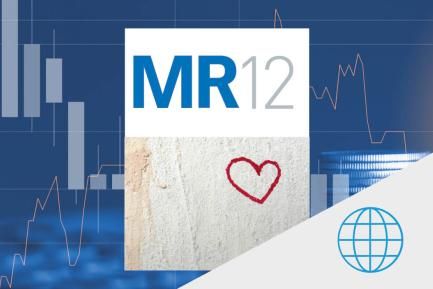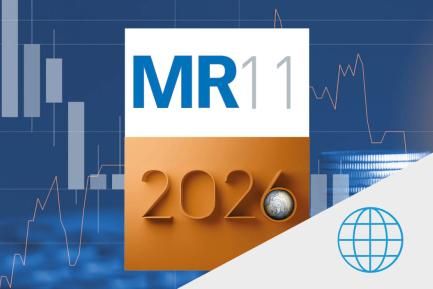
Global economy: vaccination will be the decisive factor
2021, a year in two chapters: containment and expansion
With the exception of China, which, as will become clear later, is already in a post-COVID scenario, the economic pulse of the remaining major economies will be largely determined by the vaccinations. Thus, countries that have made more progress in their immunisation campaign will enter a phase of economic expansion sooner and more decisively. In contrast, those with a slower vaccination roll-out will remain in pandemic «containment mode» for longer. To add some names, the US, with 45% of the population vaccinated with at least one dose, is already in the expansion phase, whilst most EU countries, with around 25% of the population protected, and many emerging countries are still in the containment phase. As for the time scale, the global economy as a whole should definitively enter the expansion phase in the second half of the year. This is CaixaBank Research’s outlook and it resembles that of other institutions, such as the IMF. Let us review the narrative of this latter institution, whose outlook is representative of the consensus and sheds some valuable light on what may lie ahead.

The IMF foresees a buoyant but asymmetric recovery in 2021
First and foremost, the Fund predicts a strong recovery in global growth: of 6.0% in 2021 and 4.4% in 2022. These figures are higher than the institution’s forecasts at the beginning of the year and reflect a marked improvement in the outlook for advanced countries (especially the US), as well as promising performance among emerging countries. Behind this improvement lies the battery of extra fiscal support measures, as well as a better-than-expected recovery in the second half of the year as a result of the vaccination process. While this is the overall outlook, the Fund acknowledges that the recovery will take place at different speeds, with the US leading the way among advanced countries and China among emerging ones. The euro area, in contrast, will experience weaker growth, which will prevent the region from reaching pre-pandemic levels until 2022.

Exhibit signs of improvement
With regard to the balance of risks, the IMF highlights that in the short term they are balanced, whilst in the medium term the bias is towards a better outlook. The upside risks include a better-than-anticipated evolution of the pandemic, a greater effect of the fiscal stimuli, and better coordination of economic policies than in the past. The main downside risks, meanwhile, include the resurgence of the pandemic and the tightening of financial conditions, among other factors. Taken as a whole, this balance of risks is now different and has improved in recent months.

UNITED STATES
Advanced world post-COVID, chapter one
The US growth data for Q1 2021 were eagerly awaited, as it was a quarter in which positive factors (a notable vaccination rate and a general rise in economic indicators) were combined with others more difficult to interpret (in addition to the wave of the pandemic which hit several states at the end of 2020, there was the uncertain effect of the abnormally adverse meteorological events). Finally, the US economy registered solid growth, at 1.6% quarter-on-quarter, which seems to confirm that it is entering the aforementioned new expansionary phase. How is this expansion materialising? Essentially, it is being driven by private consumption. This is important, because there are three key factors that lie behind this spike in growth, and they are likely to be repeated in other economies, albeit to varying degrees. They include: the marked improvement in incomes, driven by the fiscal stimulus, the reopening of the economy and the high vaccination rate.

Advanced world post-COVID, chapter two
The fact that the US cycle is further ahead than that of most economies is of added interest because it sheds light on two key, inter-related issues which are going to be the focus of much attention in the future. The first concerns the debate on what degree of fiscal and monetary stimulus is needed in this new phase of more decisive expansion. The second is whether there is a risk that the economic stimulus, which is on an historic scale, will fuel a substantial and permanent rebound in inflation.

If in doubt, avoid causing harm
The consensus diagnosis in the US is quite clear: the economy still has some way to go before it fully recovers, leaving aside the overheating scenario. On the contrary, the risks of reducing the fiscal and economic support too soon remain substantial. As for inflation, it is certainly going to experience a temporary rebound, largely due to the base effects of oil and the atypical consumption pattern of a year ago. However, it is expected to remain within a reasonably stable range in the medium term. In this regard, the Federal Reserve reiterates the maintenance of the monetary stimulus in its latest communications and the Board continues to forge ahead, proposing two new expansionary programmes. The first is the so-called American Jobs Plan, a 2.3-trillion-dollar infrastructure spending plan over an eight-year period which would be financed by a tax hike focused on large corporations. The second plan is known as The American Family Plan, representing some 1.8 trillion dollars over 10 years. This plan focuses on social benefits (primarily child care and education) and would be funded by raising taxes on high-earners.
EURO AREA
Advanced world post-COVID, final chapter
The euro area, as we said earlier, is on a different page. The growth data for Q1 2021 confirm that the winter COVID-19 wave, with its series of lockdowns and restrictions, has taken a toll on economic activity at the beginning of the year. In quarter-on-quarter terms, the euro area fell by 0.6% (–0.7% in Q4 2020). The available data by country, however, point to significant differences, generally determined by the variability of the pandemic in different parts of the continent. The figures are slightly better than expected in France (+0.4% quarter-on-quarter), in line with expectations in Italy and Spain (–0.4% and –0.5%, respectively) and disappointing in Germany (–1.7%).

Inflation, a distant concern
The inflation debate is also taking place in Europe, but the conclusions are no different from those presented earlier: inflation is going to rise, but this will be temporary (mainly driven by base effects of oil in the first half and, in the second half, by base effects of the German VAT cut in July 2020), and it is expected to fall back down again at the end of the year. With regard to the medium-term outlook, the dominant interpretation is that it will remain at moderate levels. For the time being, the market indicators which capture inflation expectations support this reading and suggest long-term inflation around the 1.5% mark.

EMERGING ECONOMIES
Asia, the two sides of the coin
The two major Asian economies, China and India, represent the heads and tails of the pandemic. China, as we said, is in another phase altogether. With the pandemic confined to a few controlled local outbreaks, the country has a combination of higher growth and more restrictive financial conditions compared to the other major economies. Its agenda is very different too. Firstly, the emphasis is on the quality of the recovery, not its intensity, and the growth data for Q1 2021 suggest that the economy is on the right track. Thus, despite the fact that progress was relatively meagre, at least for normal times (+0.6% quarter-on-quarter; the year-on-year rate of 18.3% is rather uninformative given the base effect of last year’s collapse), the figures show a more balanced composition with a greater role of private consumption. The government is also taking advantage of the margin provided by the growth that is now on track (remember that growth is expected to reach 8.3% in 2021) to persevere in achieving greater financial soundness (with a clean-up of low-quality debts).

The pandemic remains highly active in India and other emerging countries
he intensity of India’s latest outbreak of the pandemic has captured public attention. Although the available data in terms of victims, relative to the population, do not yet reflect the severity of the situation besides a shift in the trend, the fact is that the expectations for growth and capital inflows have been instantly affected. To a somewhat lesser extent, the prevalence of the pandemic is very significant in Brazil, among other emerging countries. The outlook of the COVID-19 pandemic will certainly not be the only determining factor for growth in emerging economies (see the Focus «Emerging economy outlook: an uneven recovery» in this same Monthly Report). Nevertheless, the figures underscore our initial statement: vaccination will mark the real turning point for the world economy, and we have not yet reached it.



